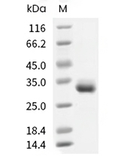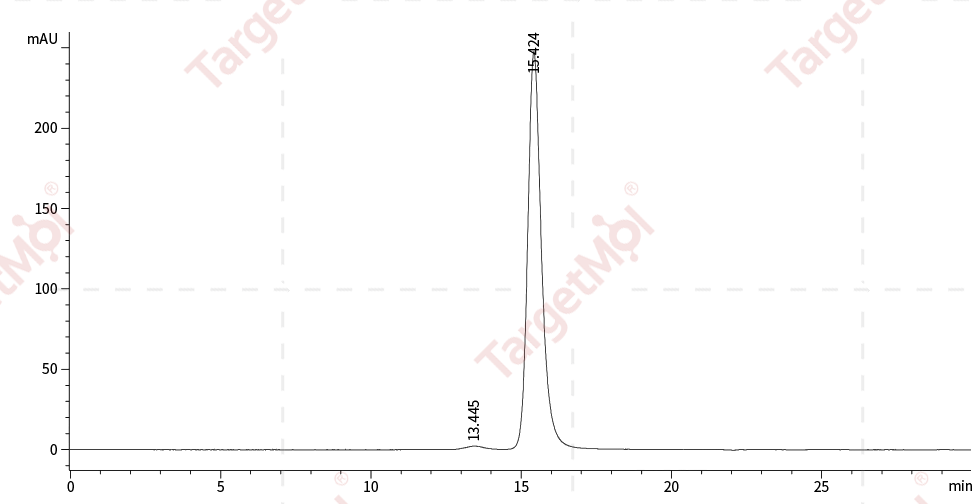Shopping Cart
Remove All Your shopping cart is currently empty
Your shopping cart is currently empty
IgG1 Fc Protein, Human, Recombinant (C103S) is expressed in HEK293 mammalian cells. The predicted molecular weight is 26 kDa and the accession number is P01857-1.

| Pack Size | Price | USA Warehouse | Global Warehouse | Quantity |
|---|---|---|---|---|
| 10 μg | $37 | - | In Stock | |
| 20 μg | $55 | 7-10 days | 7-10 days | |
| 50 μg | $98 | 7-10 days | 7-10 days | |
| 100 μg | $165 | - | In Stock |
| Biological Activity | 1. Measured by its ability to bind human CD16a-His (Cat: TMPY-01964) in a functional ELISA.
2. Measured by its ability to bind human CD16a-AVI-His (Cat: TMPY-01965) in a functional ELISA.
3.Measured by its ability to bind human CD16a-His (Cat: TMPY-00763) in a functional ELISA. |
| Description | IgG1 Fc Protein, Human, Recombinant (C103S) is expressed in HEK293 mammalian cells. The predicted molecular weight is 26 kDa and the accession number is P01857-1. |
| Species | Human |
| Expression System | HEK293 Cells |
| Tag | Tag Free |
| Accession Number | P01857-1 |
| Synonyms | Ighg1,IgG1 Fc |
| Construction | A DNA sequence encoding the human IgG1 Fc region (P01857-1) (Glu99-Lys330) (one aa mutation, 103 Cys/Ser) was expressed. Predicted N terminal: Glu 99 |
| Protein Purity | ≥ 95 % as determined by SDS-PAGE. ≥ 95 % as determined by SEC-HPLC.   |
| Molecular Weight | 26 kDa (predicted); 32 kDa (reducing condition, due to glycosylation) |
| Endotoxin | < 1.0 EU/μg of the protein as determined by the LAL method. |
| Formulation | Lyophilized from a solution filtered through a 0.22 μm filter, containing PBS, pH 7.4. Typically, a mixture containing 5% to 8% trehalose, mannitol, and 0.01% Tween 80 is incorporated as a protective agent before lyophilization. |
| Reconstitution | A Certificate of Analysis (CoA) containing reconstitution instructions is included with the products. Please refer to the CoA for detailed information. |
| Stability & Storage | It is recommended to store recombinant proteins at -20°C to -80°C for future use. Lyophilized powders can be stably stored for over 12 months, while liquid products can be stored for 6-12 months at -80°C. For reconstituted protein solutions, the solution can be stored at -20°C to -80°C for at least 3 months. Please avoid multiple freeze-thaw cycles and store products in aliquots. |
| Shipping | In general, Lyophilized powders are shipping with blue ice. |
| Research Background | As a monomeric immunoglobulin that is predominately involved in the secondary antibody response and the only isotype that can pass through the human placenta, Immunoglobulin G (IgG) is synthesized and secreted by plasma B cells, and constitutes 75% of serum immunoglobulins in humans. IgG antibodies protect the body against the pathogens by agglutination and immobilization, complement activation, toxin neutralization, as well as antibody-dependent cell-mediated cytotoxicity (ADCC). IgG tetramer contains two heavy chains (5 kDa ) and two light chains (25 kDa) linked by disulfide bonds, that is the two identical halves form the Y-like shape. IgG is digested by pepsin proteolysis into Fab fragment (antigen-binding fragment) and Fc fragment ("crystallizable" fragment). IgG1 is most abundant in serum among the four IgG subclasses (IgG1, 2, 3 and 4) and binds to Fc receptors (FcγR ) on phagocytic cells with high affinity. Fc fragment is demonstrated to mediate phagocytosis, trigger inflammation, and target Ig to particular tissues. Protein G or Protein A on the surface of certain Staphylococcal and Streptococcal strains specifically binds with the Fc region of IgGs, and has numerous applications in biotechnology as a reagent for affinity purification. Recombinant IgG Fc Region is suggested to represent a potential anti-inflammatory drug for treatment of human autoimmune diseases. |
| Size | Quantity | Unit Price | Amount | Operation |
|---|

Copyright © 2015-2025 TargetMol Chemicals Inc. All Rights Reserved.